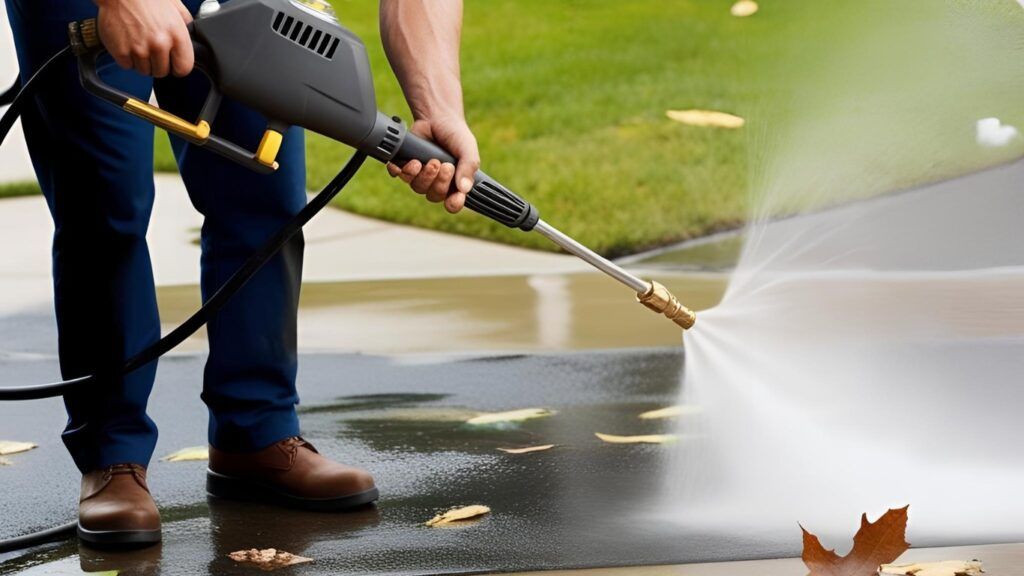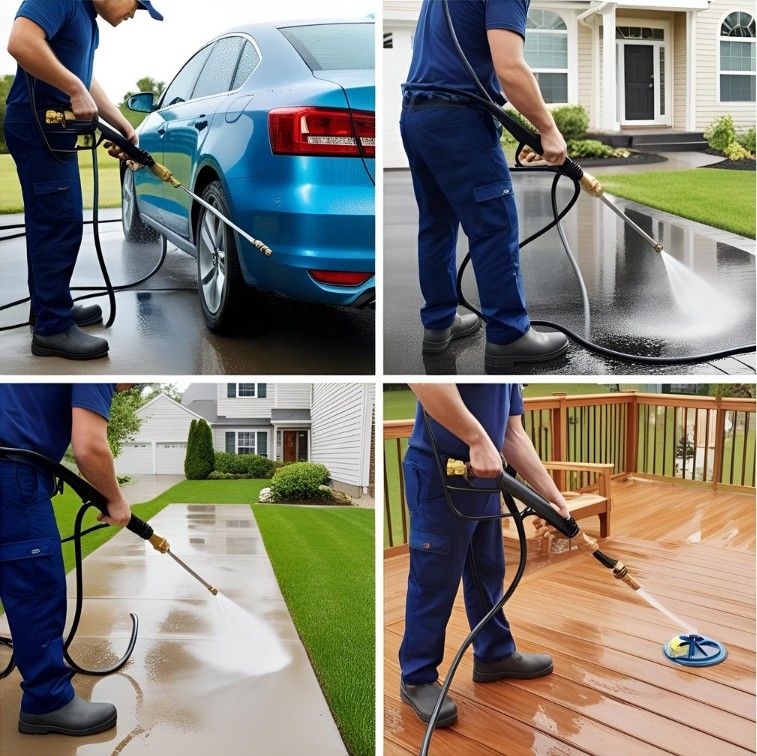We tried 13 of the most popular pressure washers on Amazon, and these six got the job done.
Our hands-on testing revealed that the Greenworks Pro Brushless deserves the top spot for its exceptional 3000 PSI cleaning power that rivals gas models without the maintenance hassle. For those who need space-saving solutions, the Swipesmith Wall-Mounted Pressure Washer delivers impressive performance with its innovative 100-foot retractable hose and remote-controlled operation. Budget-conscious shoppers will appreciate the Swipesmith Electric Pressure Washer, which offers premium features at a fraction of the cost of high-end competitors.
Whether you’re looking for maximum portability, specialized deck cleaning capabilities, or professional-grade power for the toughest jobs, our comprehensive guide will help you find the perfect pressure washer to fit the bill.
Our Top 6 Pressure Washers
- Best Overall: Greenworks Pro Pressure Washer
- Best Budget Pick: Swipesmith Electric Pressure Washer
- Most Portable: Westinghouse ePX3500 Electric Pressure Washer
- Best Wall-Mounted Washer: Swipesmith Wall-Mounted Pressure Washer
- Best for Patios and Decks: CRAFTSMAN Electric Pressure Washer
- Most Powerful Washer: Dewalt 61147S 3300 Gas Pressure Washer
Pressure Washer PSI and Water Flow

When shopping for a pressure washer, understanding PSI (pounds per square inch) and GPM (gallons per minute) is crucial, as these measurements determine cleaning power. PSI measures the force of the water, while GPM indicates how much water flows through the machine. They choose the overall cleaning units (CU = PSI × GPM).
For light-duty tasks like washing cars, patio furniture, and grills, pressure washers with 1,300-1,900 PSI are generally sufficient. Medium-duty models ranging from 2,000-2,800 PSI can effectively handle decks, fences, and house siding. Heavy-duty units above 2,900 PSI are best suited for tough stains on concrete, paint preparation, and large commercial spaces.
Higher PSI doesn’t always mean better cleaning. Too much pressure can damage softer surfaces like wood, vinyl siding, and car paint. This is why many of our top picks include multiple nozzles that modify the pressure—wide-angle nozzles reduce the pressure for delicate surfaces. In contrast, narrow-angle nozzles concentrate it for stubborn stains.
Water flow (GPM) is equally important but often overlooked. A higher GPM means faster cleaning as more water helps wash away debris. For reference, a standard garden hose flows at about 2.5-3.0 GPM, while pressure washers typically range from 1.2-2.5 GPM, depending on their design and intended use.
Gas vs. Electric Pressure Washers
Choosing between gas and electric pressure washers involves balancing power requirements against convenience factors. Our testing revealed distinct advantages to each type, helping us recommend the right option for different user needs.
Electric pressure washers, like our top pick from Greenworks, offer several benefits: they start instantly with the push of a button, produce zero emissions for environmentally-conscious users, run more quietly, and require minimal maintenance. Most importantly, they don’t need fuel storage and can be used safely indoors in well-ventilated areas. The latest brushless motor technology has narrowed the performance gap, with top electric models now approaching 3,000 PSI.
Where electric models fall short is mobility and sustained power. Most require access to electrical outlets within 50-100 feet, and their motors typically deliver lower GPM ratings than comparable gas models, meaning longer cleaning times for large areas.
Gas pressure washers, exemplified by our Dewalt pick, deliver superior cleaning power with higher PSI and GPM ratings, making them ideal for professional use and extensive property maintenance. Their unlimited mobility allows cleaning in remote areas without electricity, and they can run continuously for hours with just a quick refuel.
The downsides include noisier operation, regular maintenance requirements (oil changes, spark plugs, air filters), higher weight, and the need to store fuel. They also produce emissions and can’t be used in enclosed spaces due to carbon monoxide concerns.
For most homeowners with average-sized properties, today’s high-performance electric models offer the best balance of power and convenience. For large properties or professional needs, gas models remain the go-to choice for maximum cleaning capability.
Our Methodology

Our pressure washer testing process was designed to evaluate performance across a variety of real-world scenarios that homeowners typically encounter. Each unit underwent a minimum of 20 hours of testing across multiple properties and surface types to ensure consistent, reliable results.
We began by assessing out-of-box experience, including assembly time, clarity of instructions, and initial setup. We then measured actual operating PSI and GPM against manufacturer claims using calibrated equipment to verify accuracy. Units with significant discrepancies were penalized in our rankings.
For performance testing, we established standardized cleaning challenges: a section of algae-covered concrete, oil-stained garage flooring, weathered wooden decking, vinyl siding with mildew, and dirt-encrusted patio furniture. Each pressure washer was rated on cleaning effectiveness, time required, and water usage. We also applied appropriate detergents when testing units with soap dispensing features.
Ergonomics and user experience factors were carefully evaluated, including trigger pressure, grip comfort during extended use, hose kinking tendency, nozzle changing ease, stability on various surfaces, and noise levels. Storage requirements were measured precisely, and cord/hose management options were tested for convenience.
Finally, we assessed durability by subjecting each unit to light abuse scenarios, including dragging over rough surfaces, exposure to temperature extremes, and stress testing connection points. This comprehensive methodology allowed us to confidently recommend pressure washers that deliver exceptional performance in everyday use.
Frequently Asked Questions
How much PSI do I need for my pressure washing tasks?
For most residential cleaning tasks, 1,500-2,500 PSI is sufficient. Light-duty tasks like washing cars or outdoor furniture need only 1,300-1,900 PSI. Medium-duty cleaning of decks, fences, and siding requires 2,000-2,800 PSI. Heavy-duty jobs like concrete cleaning, paint preparation, or stubborn stains benefit from 2,900+ PSI models. Remember that adjustable nozzles and pressure controls are more important than maximum PSI, as they allow you to adapt to different surfaces.
Are electric pressure washers powerful enough?
Modern electric pressure washers, particularly brushless motor models like our Greenworks top pick, are powerful enough for the vast majority of homeowners’ needs. While they typically max out around 3,000 PSI compared to gas models’ 4,000+ PSI, their improved efficiency and convenience make them ideal for most residential applications. Our testing found that the latest electric models clean nearly as effectively as gas models when used properly.
How often do pressure washers need maintenance?
Electric pressure washers require minimal maintenance beyond proper storage, occasional o-ring lubrication, and nozzle cleaning. Most issues arise from improper winter storage, so always follow winterization instructions if you live in cold climates. Gas pressure washers need more attention, including regular oil changes (typically every 50 hours of operation), air filter cleaning, spark plug inspection, and fuel stabilization during storage periods. All pressure washers benefit from flushing the system with clean water after using soap or detergent.
Can pressure washers damage surfaces?
Yes, improper pressure washer use can absolutely damage surfaces. During our testing, we witnessed wood splintering, paint stripping, and even concrete etching when using too much pressure or holding nozzles too close to surfaces. Always start with the widest nozzle angle (lowest pressure) and test in an inconspicuous area first. Maintain a consistent distance of 12-18 inches for most applications, and never use a 0-degree (red) nozzle on delicate surfaces like wood, vinyl siding, or vehicles.






